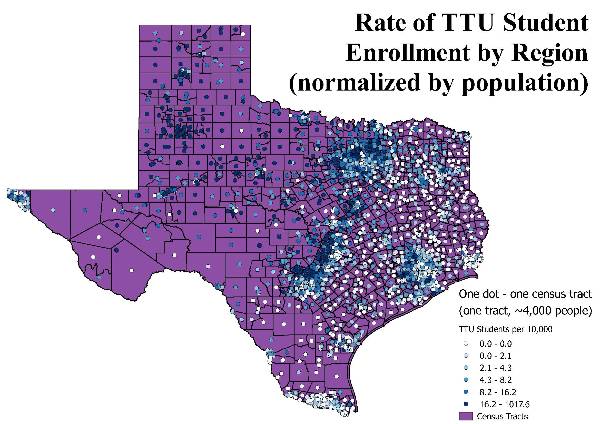The Role of Demographics: Preliminary Data on the Student Population of Texas Tech University
The following maps present the rates at which TTU draws students from various regions, based on the composition of the student body in Fall '17. Knowing where our students come from is a first tentative step towards this bigger question of impact and engagement. (Please bear with the blurry/pixelated maps. If you would like to use some version of these in your work, please contact the A&S grant editor). The density of the dots reflects the population density of the state; the shading of the dots reflect the rate at which we are recruiting from a given area. Thus we recruit at the fastest pace from those regions with a high density of dark-blue dots.

The scope of TTU's highest geographic influence is clearly all around it, running through the rural regions from Lubbock to Dallas. Remember that this is a region of some of the lowest population density and some of the lowest educational attainment surrounding any top tier research institute in the nation. Nevertheless, we have a steady clip of enrollment once normalized for population. Beyond the Dallas-Fort Worth area, we know that students are presented with a vast number of four-year options that will also be closer-to-home for them than TTU; it is not a surprise that students come to TTU at a lower rate. Yet, with the population density being many times higher in these regions, we still receive the bulk of our students from Dallas, Austin, and Houston.
Nevertheless, a distinction must be drawn between where the bulk of TTU students come from and where the bulk of TTU's impact is felt. Click through to this ACE report on gaps in education availability and compare the swaths of the country labeled education deserts to the swaths of the South Plains where TTU is recruiting at high rates. The impact of students from the major population centers of Texas is undoubtedly strong not only in terms of overall recruitment numbers, but the culture of the university. Yet if we flip the question and ask about the impact of Texas Tech University on a given region, it is in the education deserts of West Texas and the Texas panhandle. Here we find a perfect storm of risk factors for educational attainment--high rates of agricultural employment, low diversity of industry, low rates of educational attainment, and a high population of low socioeconomic status individuals. With a century of outreach and engagement in such regions, Texas Tech University is not new to this responsibility, but it is a commitment that must be renewed with every generation.
***
With Texas Tech University on the path to becoming a Hispanic-serving institution, it is worth looking at where these students come from. As before, we should mention a few caveats regarding both the map we just looked at and the one to come. The shading reflects the particular composition of our student body in Fall '17. Fall '18 could see a different distribution; any given white dot (corresponding to zero students from that particular region) could see a half-dozen students suddenly appear and make the region look as if it were the epicenter of a major recruitment event. But it would probably just be statistical noise. More significant is the state-level story:

For any given region that sent students to TTU, this map presents the proportion of those students that were Hispanic. The previous map tells us, for instance, that we've only had moderate success in recruiting from El Paso and the Rio Grande Valley; this map tells us, however, that among the students that did come from these areas, a remarkable proportion of them are Hispanic. This is not news given the demographics of these areas, yet it is also not automatic to have any recruiting success at all in these regions.
It also seems worth noting the extent to which this is not just a story of one or two highly Hispanic regions. Modern Texas is a heavily Hispanic state. Though we have recently crossed 25% Hispanic enrollment at TTU, this significantly lags the demographics of our high schools, the graduating classes of which have been majority Hispanic since 2013. If an aspiration of higher education is democratization, then we have a ways to go.
College of Arts & Sciences
-
Address
Texas Tech University, Box 41034, Lubbock, TX 79409-1034 -
Phone
806.742.3831 -
Email
arts-and-sciences@ttu.edu
